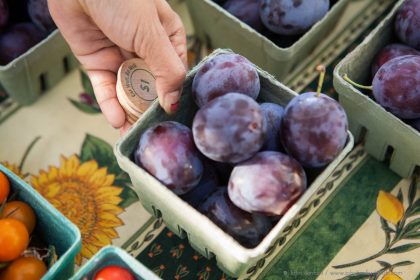
This post was originally published on the New Hampshire Food Alliance website.
The New Hampshire Food Alliance is excited to announce the Farm, Fish, and Food Enterprise Viability Initiative. This initiative entails several areas of opportunity where the network can create conditions that will lead to more profitable and sustainable farm, fish, and food enterprises including Education, Land Resources and Access, Market Development, and Food Accessibility. In order to illustrate the great work that is already being done in these areas, we have compiled a series of blog posts to share success stories. This Spotlight on the Viability Initiative focuses on the opportunity area of Food Accessibility.
 Tony, a New Hampshire Food Stamp recipient, was told that to lose weight he needed to eliminate sweets and highly processed foods from his diet. Thanks to a partnership between the New Hampshire Food Bank and Wholesome Wave, New Hampshire SNAP (Food Stamp) recipients can now receive extra funds for the purchase of fruits and vegetables at farmers’ markets. Called Granite State Market Match, the program matches SNAP dollar for dollar (up to a $10 cap in some locations) at participating markets. With the Market Match program, Tony now shops at four different participating farmers’ markets, giving him an extra $40 each week to spend on healthy food options. With the matching funds, Tony has not only made healthier food choices (he has lost 65 pounds), but he is also supporting local farms.
Tony, a New Hampshire Food Stamp recipient, was told that to lose weight he needed to eliminate sweets and highly processed foods from his diet. Thanks to a partnership between the New Hampshire Food Bank and Wholesome Wave, New Hampshire SNAP (Food Stamp) recipients can now receive extra funds for the purchase of fruits and vegetables at farmers’ markets. Called Granite State Market Match, the program matches SNAP dollar for dollar (up to a $10 cap in some locations) at participating markets. With the Market Match program, Tony now shops at four different participating farmers’ markets, giving him an extra $40 each week to spend on healthy food options. With the matching funds, Tony has not only made healthier food choices (he has lost 65 pounds), but he is also supporting local farms.
For farmers, the additional income from the program is seen as a win-win: “We benefit financially, the customers benefit financially [and] we all are happier and healthier.” Farmers at the Hollister Family Farm believe that Granite State Market Match is a, “smart move for customers, financially.” Additionally, “as customers learn about us as farmers, they learn about the vegetables. [I] love that customers are eating well.”
The NH Food Bank, a sub-awardee of the USDA Food Insecurity Nutrition Incentive grant, will distribute $130,000 (over 3 years) to New Hampshire Food Stamp recipients, which with the match from recipients could add up to over $300,000 for farmers as income. This is a great example of how a systems approach to addressing one problem—limited accessibility—leverages resources to enhance another aspect of the system—increasing farmer income. In addition, eating a healthier diet translates into “price-less” benefits for consumers, and reduced health care costs for us all. By focusing on food accessibility within the Viability Initiative, we can respond to challenges and opportunities across food system sectors.
Jennifer Wilhelm is a Research and Planning Associate with the New Hampshire Food Alliance. Her work focuses on the research, data analysis, and communication aspects of the NH Food Alliance network. Currently she is working on a research report of the socio-economic state of New Hampshire’s food system, which evaluates different food systems metrics (production and distribution, farm and fishery viability, supply and demand, food access and security, public health, and organized efforts and network collaborations). Jennifer is also a doctoral candidate in agroecology at the University of New Hampshire. She is using spatial analyses, as well as agricultural land-use scenario modelling to determine where agricultural production can be increased in New England and at what ecological costs.
Photo courtesy of John Benford Photography




